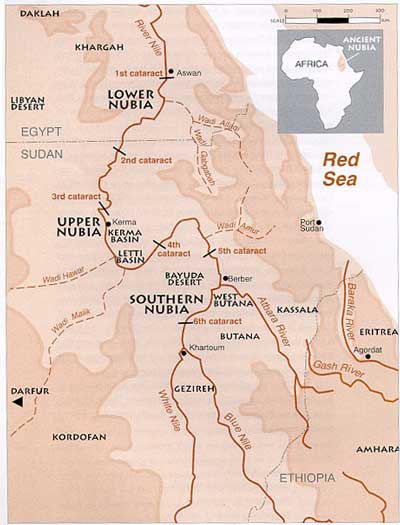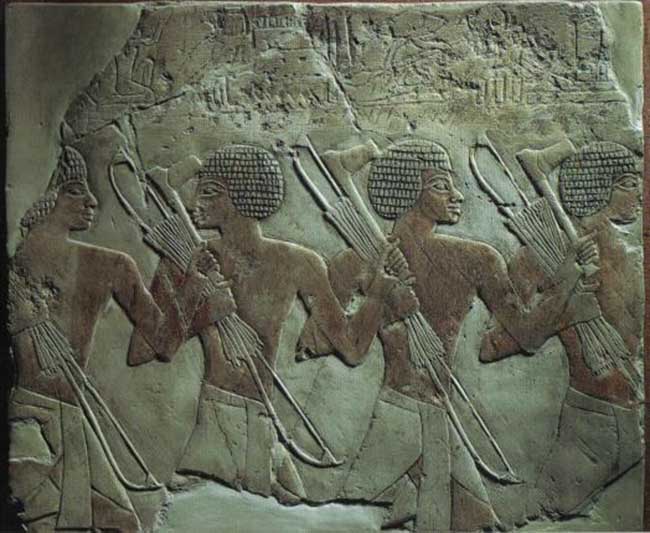Nubia was also called -
Upper & Lower Nubia, Kush, Land of Kush, Te-Nehesy, Nubadae, Napata, or the
Kingdom of Meroe.
The region referred to
as Lower Egypt is the northernmost portion. Upper Nubia extends south into
Sudan and can be subdivided into several separate areas such as Batn El Hajar
or "Belly of Rocks", the sands of the Abri-Delgo Reach, or the flat
plains of the Dongola Reach. Nubia, the hottest and most arid region of the
world, has caused many civilizations to be totally dependent on the Nile for
existence.
Historically Nubia has
been a nucleus of diverse cultures. It has been the only occupied strip of land
connecting the Mediterranean world with "tropical" Africa. Thus, this
put the people in close and constant contact with its neighbors for long
periods of history and Nubia was an important trade route between sub-Saharan
Africa and the rest of the world. Its rich material culture and tradition of
languages are seen in archaeological records.
The most prosperous
period of Nubian civilization was that of the kingdom of Kush, which endured
from about 800 BC to about 320 AD. During this time, the Nubians of Kush would
at one point, assume rule over all of Nubia as well as Upper and Lower Egypt.
The regions of Nubia,
Sudan and Egypt are considered by some to be the cradle of civilization. Today
the term Nubian has become inclusive of Africans, African Arabs, African
Americans and people of color in general.
Nubia is divided into
three regions: Lower Nubia, Upper Nubia, and Southern Nubia. Lower Nubia was in
modern southern Egypt, which lies between the first and second cataract. Upper
Nubia and Southern Nubia were in modern-day northern Sudan, between the second
cataract and sixth cataracts of the Nile river. Lower Nubia and Upper Nubia are
so called because the Nile flows north, so Upper Nubia was further upstream and
of higher elevation, even though it lies geographically south of Lower Nubia.

Early settlements
sprouted in both Upper and Lower Nubia: The Restricted flood plains of Lower
Nubia. Egyptians referred to Nubia as "Ta-Seti." The Nubians were
known to be expert archers and thus their land earned the appellation,
"Ta-Seti", or land of the bow. Modern scholars typically refer to the
people from this area as the ÒA-groupÓ culture. Fertile farmland just south of
the third cataract is known as the ÒPre-KermaÓ culture in Upper Nubia, as they
are the ancestors civilization originated in 5000 BC in Upper Nubia..
The Neolithic people in
the Nile valley likely came from Sudan, as well as the Sahara, and there was
shared culture with the two areas and with that of Egypt during this time
period.
By the 5th millennium
BC, the people who inhabited what is now called Nubia participated in the
Neolithic revolution. Saharan rock reliefs depict scenes that have been thought
to be suggestive of a cattle cult, typical of those seen throughout parts of
Eastern Africa and the Nile Valley even to this day.
Megaliths discovered at
Nabta Playa are early examples of what seems to be one of the world's first
astronomical devices, predating Stonehenge by almost 2000 years. This
complexity as observed at Nabta Playa, and as expressed by different levels of
authority within the society there, likely formed the basis for the structure
of both the Neolithic society at Nabta and the Old Kingdom of Egypt.
Around 3800 BC, the
second "Nubian" culture, termed the A-Group, arose. It was a
contemporary of, and ethnically and culturally very similar to, the polities in
predynastic Naqada of Upper Egypt.
Around 3300 BC, there
is evidence of a unified kingdom, as shown by the finds at Qustul, that
maintained substantial interactions (both cultural and genetic) with the
culture of Naqadan Upper Egypt. The Nubian culture may have even contributed to
the unification of the Nile valley. Also, the Nubians very likely contributed
some pharaonic iconography, such as the white crown and serekh, to the Northern
Egyptian kings.
Around the turn of the
protodynastic period, Naqada, in its bid to conquer and unify the whole Nile
valley, seems to have conquered Ta-Seti (the kingdom where Qustul was located)
and harmonized it with the Egyptian state. Thus, Nubia became the first nome of
Upper Egypt. At the time of the first dynasty, the A-Group area seems to have
been entirely depopulated most likely due to immigration to areas west and
south.
This culture began to
decline in the early 28th century BC. The succeeding culture is known as
B-Group. Previously, the B-Group people were thought to have invaded from
elsewhere. Today most historians believe that B-Group was merely A-Group but
far poorer. The causes of this are uncertain, but it was perhaps caused by
Egyptian invasions and pillaging that began at this time. Nubia is believed to
have served as a trade corridor between Egypt and tropical Africa long before
3100 BC. Egyptian craftsmen of the period used ivory and ebony wood from
tropical Africa which came through Nubia.
In 2300 BC, Nubia was
first mentioned in Old Kingdom Egyptian accounts of trade missions. From Aswan,
right above the First Cataract, southern limit of Egyptian control at the time,
Egyptians imported gold, incense, ebony, ivory, and exotic animals from
tropical Africa through Nubia. As trade between Egypt and Nubia increased so
did wealth and stability.
By the Egyptian 6th
dynasty, Nubia was divided into a series of small kingdoms. There is debate
over whether these C-Group peoples, who flourished from c. 2240 BC to c. 2150
BC, were another internal evolution or invaders. There are definite
similarities between the pottery of A-Group and C-Group, so it may be a return
of the ousted Group-As, or an internal revival of lost arts. At this time, the
Sahara Desert was becoming too arid to support human beings, and it is possible
that there was a sudden influx of Saharan nomads. C-Group pottery is
characterized by all-over incised geometric lines with white infill and
impressed imitations of basketry.
During the Egyptian
Middle Kingdom (c. 2040-1640 BC), Egypt began expanding into Nubia to gain more
control over the trade routes in Northern Nubia and direct access to trade with
Southern Nubia. They erected a chain of forts down the Nile below the Second
Cataract. These garrisons seemed to have peaceful relations with the local
Nubian people but little interaction during the period. A contemporaneous but
distinct culture from the C-Group was the Pan Grave culture, so called because
of their shallow graves. The Pan Graves are associated with the East bank of
the Nile, but the Pan Graves and C-Group definitely interacted. Their pottery
is characterized by incised lines of a more limited character than those of the
C-Group, generally having interspersed undecorated spaces within the geometric
schemes.

The history of the
Nubians is closely linked with that of ancient Egypt. Ancient Egypt conquered
Nubian territory incorporating them into its provinces. The Nubians in turn
were to conquer Egypt in its 25th Dynasty. However, relations between the two
peoples also show peaceful cultural interchange and cooperation, including
mixed marriages.
The Medjay represents
the name Ancient Egyptians gave to a region in northern Sudan where an ancient
people of Nubia inhabited. They became part of the Ancient Egyptian military as
scouts and minor workers. During the Middle Kingdom "Medjay" no
longer referred to the district of Medja, but to a tribe or clan of people. It
is not known what happened to the district, but, after the First Intermediate
Period, it and other districts in Nubia were no longer mentioned in the written
record.
Written accounts detail
the Medjay as nomadic desert people. Over time they were incorporated into the
Egyptian army where that served as garrison troops in Egyptian fortifications
in Nubia and patrolled the deserts. This was done in the hopes of preventing
their fellow Medjay tribespeople from further attacking Egyptian assets in the
region. They were later used during KamoseÕs campaign against the Hyksos and
became instrumental in making the Egyptian state into a military power.
By the 18th Dynasty of
the New Kingdom the Medjay were an elite paramilitary police force. No longer
did the term refer to an ethnic group and over time the new meaning became
synonymous with the policing occupation in general. Being an elite police
force, the Medjay were often used to protect valuable areas, especially royal
and religious complexes. Though they are most notable for their protection of
the royal palaces and tombs in Thebes and the surrounding areas, the Medjay
were known to have been used throughout Upper and Lower Egypt.
Various pharaohs of
Nubian origin are held by some Egyptologists to have played an important part
towards the area in different eras of Egyptian history, particularly the 12th
Dynasty. These rulers handled matters in typical Egyptian fashion, reflecting
the close cultural influences between the two regions.
The XII Dynasty
(1991-1786 B.C.E.) originated from the Aswan region. As expected, strong Nubian
features and dark coloring are seen in their sculpture and relief work. This
dynasty ranks as among the greatest, whose fame far outlived its actual tenure
on the throne. Especially interesting, it was a member of this dynasty that
decreed that no Nehsy (riverine Nubian of the principality of Kush), except
such as came for trade or diplomatic reasons, should pass by the Egyptian
fortress and cops at the southern end of the Second Nile Cataract.
In the New Kingdom,
Nubians and Egyptians were often closely related that some scholars consider
them virtually indistinguishable, as the two cultures combined. The result has
been described as a wholesale Nubian assimilation into Egyptian society. This
assimilation was so complete that it masked all Nubian ethnic identities
insofar as archaeological remains are concerned beneath the impenetrable veneer
of Egypt's material culture.
In the Kushite Period,
when Nubians ruled as Pharaohs in their own right, the material culture of
Dynasty XXV (about 750-655 B.C.E.) was decidedly Egyptian in character. Nubia's
entire landscape up to the region of the Third Cataract was dotted with temples
indistinguishable in style and decoration from contemporary temples erected in
Egypt. The same observation obtains for the smaller number of typically
Egyptian tombs in which these elite Nubian princes were interred.

No comments:
Post a Comment